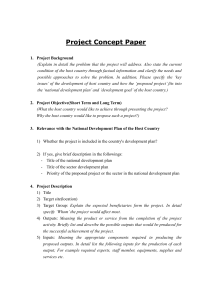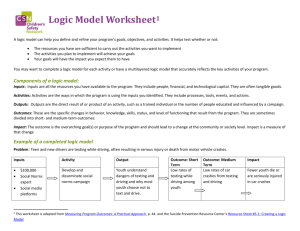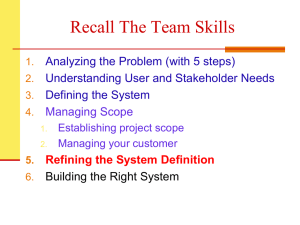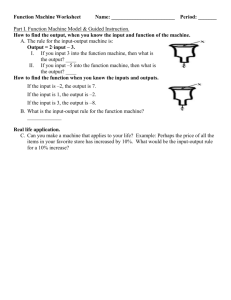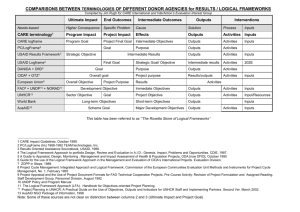What is a programme logic model?
advertisement
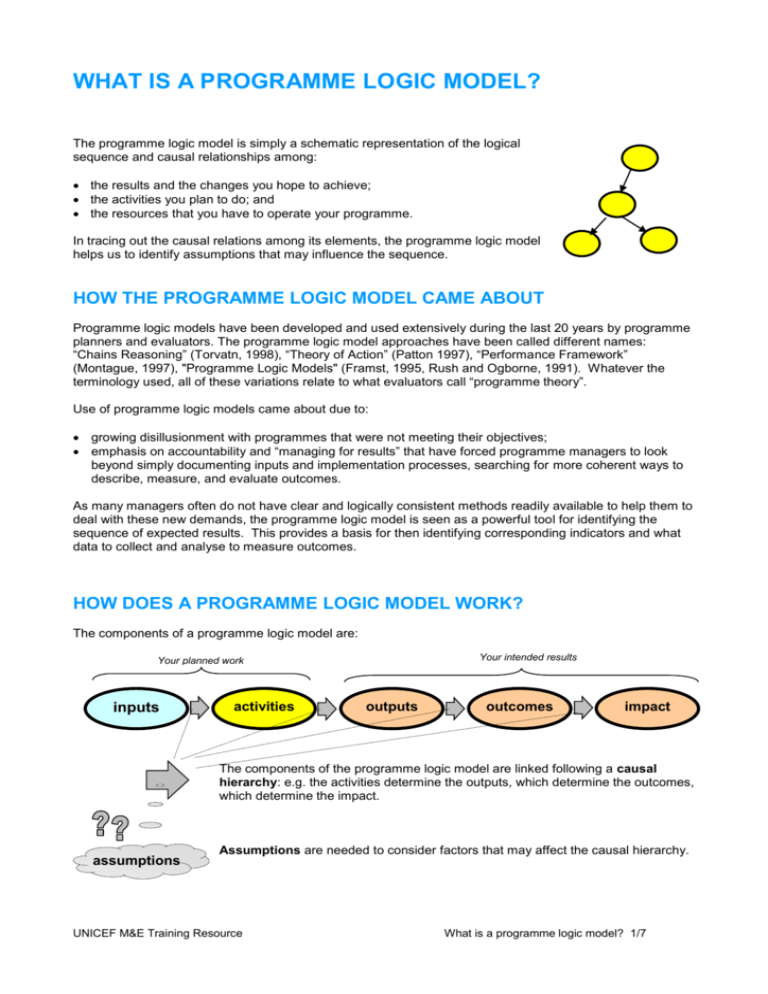
WHAT IS A PROGRAMME LOGIC MODEL? The programme logic model is simply a schematic representation of the logical sequence and causal relationships among: the results and the changes you hope to achieve; the activities you plan to do; and the resources that you have to operate your programme. In tracing out the causal relations among its elements, the programme logic model helps us to identify assumptions that may influence the sequence. HOW THE PROGRAMME LOGIC MODEL CAME ABOUT Programme logic models have been developed and used extensively during the last 20 years by programme planners and evaluators. The programme logic model approaches have been called different names: “Chains Reasoning” (Torvatn, 1998), “Theory of Action” (Patton 1997), “Performance Framework” (Montague, 1997), "Programme Logic Models" (Framst, 1995, Rush and Ogborne, 1991). Whatever the terminology used, all of these variations relate to what evaluators call “programme theory”. Use of programme logic models came about due to: growing disillusionment with programmes that were not meeting their objectives; emphasis on accountability and “managing for results” that have forced programme managers to look beyond simply documenting inputs and implementation processes, searching for more coherent ways to describe, measure, and evaluate outcomes. As many managers often do not have clear and logically consistent methods readily available to help them to deal with these new demands, the programme logic model is seen as a powerful tool for identifying the sequence of expected results. This provides a basis for then identifying corresponding indicators and what data to collect and analyse to measure outcomes. HOW DOES A PROGRAMME LOGIC MODEL WORK? The components of a programme logic model are: Your intended results Your planned work inputs activities outputs outcomes impact The components of the programme logic model are linked following a causal hierarchy: e.g. the activities determine the outputs, which determine the outcomes, which determine the impact. assumptions Assumptions are needed to consider factors that may affect the causal hierarchy. UNICEF M&E Training Resource What is a programme logic model? 1/7 Components of the programme logic model: inputs, activities, outputs, outcomes, impact. inputs Inputs are the resources— human, financial, material, technological and information —used in a development or humanitarian response intervention. In the programme model, we focus on inputs needed for an activity to produce the expected output. Activities transform inputs into outputs. They involve: activities outputs outcomes impact specific actors; processes with specific characteristics (such as wider participation, approaches that foster skills-building). Outputs are the products (goods, services, etc.) that result from the completion of an activity. Outcomes are the intended or achieved short-term and medium-term effects generated by the outputs. Programme planners expect that programme outputs will lead to outcomes such as changes in behaviour, knowledge, skills, and status. Outcomes are expected to lead to positive impact. “Impact” is the longer-term result of a programme (technical, economic, socio-cultural, institutional, environmental or other) whether direct or indirect, intended or unintended, negative or positive. For UNICEF, organisational policy on human rightsbased approach to programming implies that intended impact must be articulated in terms of results for children, women, and families. Also, included in the long-term results are those secondary, indirect or downstream results (referred to by economists as “externalities”) of the programme that can affect, either positively or negatively, primary stakeholders. For example, in a programme that provides supplementary income to lowincome families when they enrol their children in school, the increased income can stimulate local production of consumer goods and services to meet the demand created, thus generating additional jobs and income. The components defined here reflect the “result-based terminology” that is comparable to a programme hierarchy: intended impact corresponds to the programme goal and outcomes correspond to programme objectives. UNICEF M&E Training Resource What is a programme logic model? 2/7 The causal relationship among the programme logic model components A programme logic model shows the causal connections among its components, the “if…then…” relationship among its parts. inputs activities If programme managers can mobilise the resources identified in the programme logic model, and certain assumptions hold true, then they will be able to implement the activity. outputs If the necessary inputs are used effectively, involving the appropriate actors in appropriate processes, and certain assumptions hold true, then the activity will yield the expected products outcomes If the outputs from all the planned activities are achieved as expected, and certain assumptions hold true, the outputs will converge to bring about the expected short- or mediumterm results, the outcomes. impact If the outcomes from different programmes are achieved, and certain assumptions hold true, then certain changes in populations’ well being, institutions or systems might be expected to occur. Adapted from: Kellogg Foundation (2001). Logic Model Development guide (http://www.wkkf.org/pubs/Pub3669.pdf) Contextual factors and assumptions inputs activities outputs outcomes impact The process of thinking through the relationships between the problems addressed and the factors that cause the problems enables programme managers to make better and more informed decisions about programme design and to make their assumptions explicit. This helps a more realistic planning for results. assumptions The causal relations between the components of a programme logic model may be affected (positively or negatively) by key contextual factors external to the programme and not under its control (macroeconomic conditions, political influences, and weather conditions, for example). The causal hierarchy might include internal assumptions about complementary programmes managed by other organisations. For example, consider how different organisations and institutions might work to achieve complementary or even the same outcomes, in different partnership arrangements, each organisation filling in a particular niche according to its capacities. UNICEF M&E Training Resource What is a programme logic model? 3/7 The process Programme logic model approaches involve ideally more than producing a simple diagram or graphic. They can be used in a highly participatory process, facilitating dialogue and discussion among programme partners and yielding a clear, common understanding of the programme intent and strategy. The participatory approaches to programme logic modelling include ZOPP (Ziel Orientierte Projek Planung) or Objectives Oriented Project Planning. The methods and techniques of Visualisation in Participatory Planning (VIPP), familiar to many UNICEF staff, are entirely complementary to participatory approaches to programme logic modelling. See: GTZ (1997). ZOPP - Objectives-oriented Project Planning (http://www.gtz.de/pcm/download/english/zopp_e.pdf). UNICEF M&E Training Resource What is a programme logic model? 4/7 COMPLEX PROGRAMME LOGIC MODELS In practice the chain of components may be more complex than the linear pattern presented so far. For example: An outcome may be determined by a set of concurrent activities Goal/ Expected impact Objective/ Expected outcome Expected output Expected output Expected output Activity 1 Activity 2 Activity 3 Inputs Inputs Inputs The output of an activity or project may become the input for another activity or project Secondary effects Impact Assumptions Outcome A Outcome B Assumptions Expected output Expected output Assumptions Assumptions Activity Activity Assumptions Assumptions Expected output Inputs Inputs Expected output Expected output Assumptions Assumptions Activity 1 Activity 2 Activity 3 Assumptions Assumptions Inputs UNICEF M&E Training Resource Inputs Inputs What is a programme logic model? 5/7 EXAMPLE OF A PROGRAMME LOGIC MODEL A programme logic model can help in tracing out the sometimes-complex lateral causal links between different streams of activities. Basic education for all children Other sub-goals also contribute Increased attendance boys/girls Increased commitment of parents Perceived relevance for girls and boys Threats to girls attending decrease Organise chaperone teams for girls Increased role for parents Leaders’ support and promotion to parents Promote curriculum to parents/ teachers Construction of separate latrines Compensation for chaperones Mobilisation in community Revise curriculum to increase life skills content Review by parents/ teachers Expertise on life skills content Pedagogical expertise UNICEF M&E Training Resource Establish parent-teachers association Supervisors’ support Leaders’ support School policy Construction materials Technical design support What is a programme logic model? 6/7 Labour SUMMARY: THE WHY, WHAT, WHO, WHEN, HOW OF PROGRAMME LOGIC MODELS A programme logic model should create an explicit understanding of the components of a programme (and of the contextual factors influencing them) and of its logic in order to: Provide a basis for better planning, monitoring, evaluation; Enhance communication of the programme among programme stakeholders. Programme logic models need to state: The components of a programme; The different actors involved and their various contributions and roles at different points in the programme, including the populations intended to benefit from the programme outputs, outcomes and impact; The logic connections, critical linkages and sequencing amongst the activities (if…then…). This means to identify what to do — and in what sequence — in order to achieve the ultimate outcomes and impact desired; The assumptions to be made on such connections. The analysis of the external factors affecting the components of the programme logic model provides the basis for managers to address risk factors or to make strategic decisions that could lead to greater effectiveness and sustainability. All relevant stakeholders must be involved in the preparation/revision of programme logic models: Developing and using programme logic models with programme partners can involve considerable discussion, but tends to lead to a much more realistic programme logic model and M&E plan than one drawn up by one person. Time must be allowed for this participatory process. Programme logic models may become an opportunity to involve partners and primary stakeholders in a truly participatory fashion. The more participatory the process, the more it can help to test the logical sequence envisioned by programme planners against the logic of other participants, including primary stakeholders. Developing programme logic models is an ongoing process. Programme logic models can be produced and employed at all stages of the project cycle: as a reference in defining indicators for a monitoring plan; as a reference in defining evaluation questions; as a tool in the actual design and implementation of evaluations. Developing a programme logic model, especially identifying and organising its components, is an iterative process. Programme logic models should be continuously adapted. They require careful review and, often, several revisions, so it is important to test and retest the logical connections and completeness. Developing a programme logic model is an iterative process that should include the relevant stakeholders of a programme. It requires many of the same basic steps as good programme formulation. (See core content sheet “Steps in developing programme logic models”) UNICEF M&E Training Resource What is a programme logic model? 7/7




